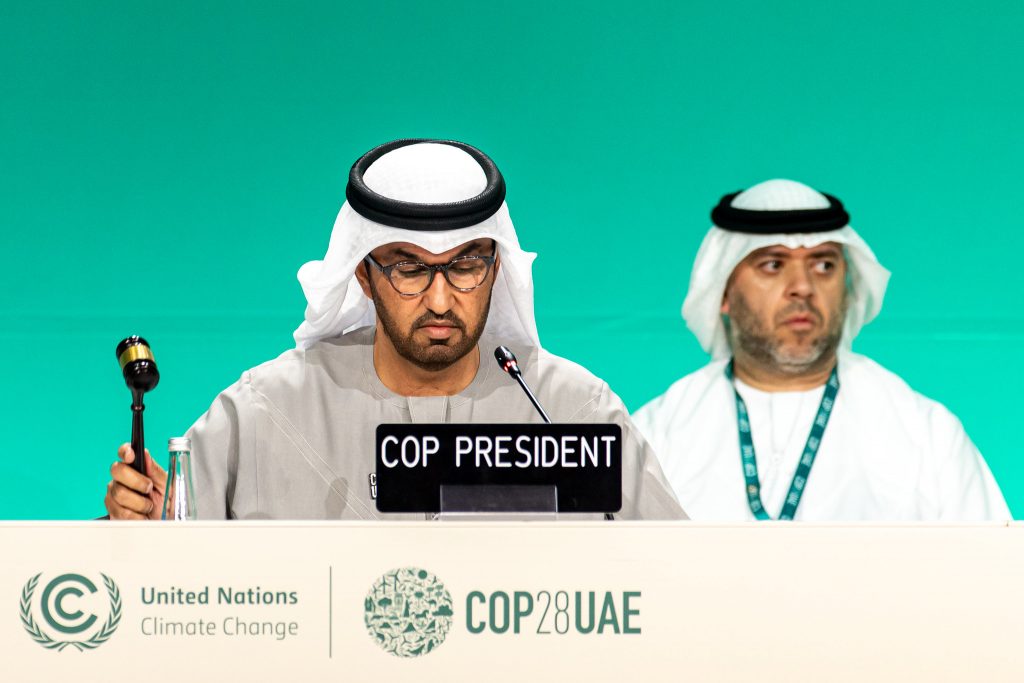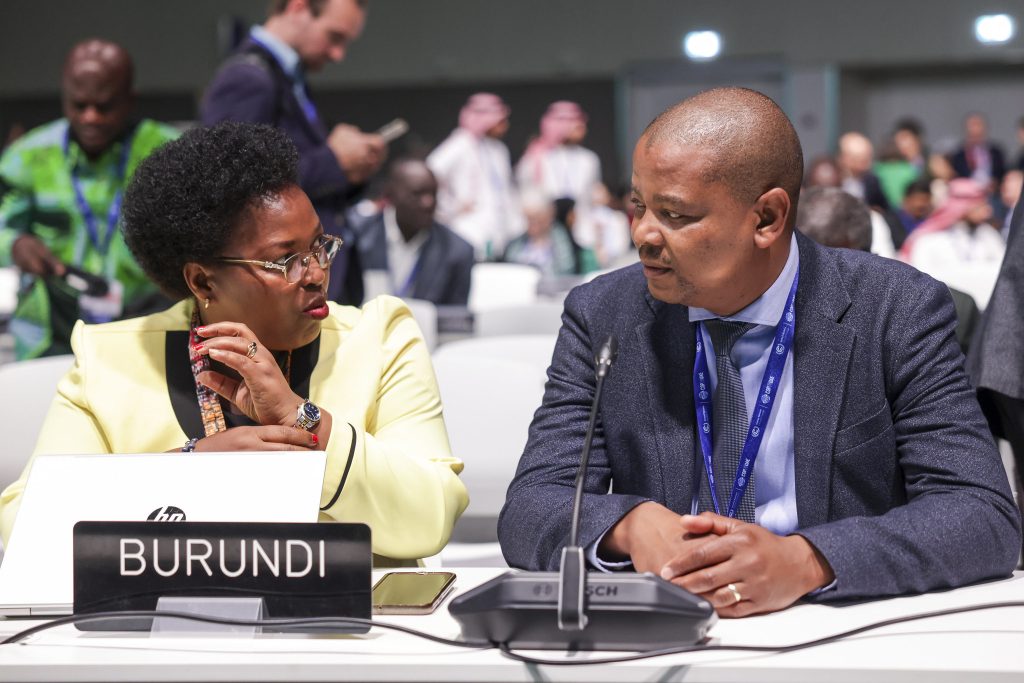At the end of last year you may have heard about COP28 – and, in the years before that, COP27, COP26, and so on. These are annual summits, organised by the United Nations, and are focused on tackling climate change. They’re the most important way we can coordinate global action on the biggest issue of our time.
At COP21, in 2015, attendees created the Paris Agreement: a worldwide treaty committing nations to keep global warming below 1.50C, and definitely below 20C. The COP summits use these targets as their guiding principle.
When the Paris Agreement was signed, we were due for well over 30C of warming; this has now been reduced to about 2.80C. This is still far too much, but shows that international collaboration works.
But what happens at a COP summit, and was this year’s COP conference helpful?

What are the COP summits?
The COP (“Conference of the Parties”) summits are major international meetings that take place annually and are hosted by a different country each year. They are attended by almost every country on the planet, who send senior government ministers and officials to negotiate treaties and deals that tackle climate change.
Governments aren’t the only ones who attend: tens of thousands of representatives from charities, businesses, marginalised communities, and other interest groups attend too. Everyone is seeking to contribute to the process and create a joined-up, worldwide planetary front against global warming.
What about COP28?
2023’s COP conference took place in Dubai, in the United Arab Emirates. Controversially, it was chaired by Dr Sultan Ahmed al Jaber, the president of a major oil company. Many were sceptical that a country, whose wealth was built on oil money, would do anything meaningful towards climate change; it would be against their interests to support anything that reduced fossil fuel usage. On the other hand, oil companies can see climate change happening around us already, and we simply can’t transition to clean energy without a place for fossil fuel companies in the short term. Not to mention that the UAE – as a desert country – is on the very frontlines of global warming. So there was a lot of pressure on Dr Al Jaber to deliver a meaningful outcome from COP28 that would satisfy countries reliant on fossil fuels and those demanding decisive climate action.
What were the goals and were they successful?
There were four official goals set by the COP28 presidency, but there was also another important, unofficial goal that many countries were pushing for. Let’s look at each of these in turn.
1 – FAST-TRACKING THE ENERGY TRANSITION AND SLASHING EMISSIONS BEFORE 2030
What does it mean? Increasing the speed at which countries install renewable energy such as solar and wind, and making sure that the release of gases like CO2 and (in particular) methane are reduced from existing fossil fuel plants.
Why does it matter? Globally, about thirty percent of greenhouse gas emissions come from electricity generation. The good news is that wind and solar have become some of the cheapest possible ways of generating electricity. Helping countries to build as many of these renewable energy plants (along with supporting infrastructure) will take a massive bite out of our global carbon footprint. As for methane – it’s a very potent greenhouse gas; it is thirty times more effective at trapping heat than carbon dioxide. Reducing emissions of methane now gives us breathing room on global warming, and makes us less likely to cross dangerous tipping points from temperature rise in the short term.
Did it succeed? Yes, good progress was made here. 118 countries signed up to a deal to, between them, triple their renewable energy capacity by 2030. Some of them were going above this target (because they were starting from a lower base), others below (because they had already done so much work to install renewables already). Key agreements were made on reducing methane emissions, with 155 countries signing the Global Methane Pledge to reduce methane emissions by 30% by 2030 and deliver $1bn in new investments to make that possible.
2 – DELIVER OLD PROMISES AND SET THE FRAMEWORK FOR A NEW DEAL ON FINANCE
What does it mean? Create a new system of global rules and deals that make it cheaper and more attractive for governments and big businesses to invest in the new technologies and upgrades needed to reduce emissions.
Why does it matter? $2.4 trillion dollars of investment is required every year by 2030 to pay for the expensive changes that our civilisation needs to limit global warming to 1.50C. All those new wind farms aren’t going to pay for themselves – especially in developing countries that can’t just borrow cheap money to build them, or that lack homegrown industries capable of installing them. This funding gap can be bridged by finding incentives for the wealthiest countries and businesses to make these investments in a way that benefits them without exploiting developing countries.
Did it succeed? This category had some of the most mixed results of the conference. Despite lots of negotiations, no major new agreements were made at this stage. A lot of money was pledged by wealthier countries for various climate funds, but it fell far short of the $2.4 trillion required.

3 – PUT NATURE, PEOPLE, LIVES AND LIVELIHOODS AT THE HEART OF CLIMATE ACTION
What does it mean? In practice, one of the key desired outcomes from this line of work was to follow up on COP27’s agreement for a Loss and Damage fund, where poorer countries in the developing world could access money from wealthy countries to help mitigate and cope with the impact of climate change in the short term (such as droughts, storms, flooding, and so on).
Why does it matter? Climate change is happening now, and it’s affecting some of the poorest countries in the world. Meanwhile, rich countries, that are responsible for the majority of emissions, are yet to feel climate disruption in full force, and have the financial and organisational means at their disposal to deal with these impacts. It’s not just a matter of justice; many poorer countries also hold out for this kind of support as a goodwill gesture, so they can begin to investigate making sustainable adaptations themselves.
Did it succeed? This is one of the clearest wins of COP28. On the first day of the conference, an agreement was announced to fund $700m for the Loss and Damage fund. While much more money is needed, this was an early win and is something that can be built on in subsequent conferences.
4 – MOBILIZE FOR THE MOST INCLUSIVE COP
What does it mean? In UN terms, inclusivity extends to marginalised groups such as women, children, indigenous communities, “people of determination” (which generally means disabled people), as well as groups such as regional governments and faith organisations. (For example, Pope Francis made a statement in favour of ending fossil fuel use for the conference.)
Why does it matter? I don’t think anyone will argue that marginalised groups should be brought into discussions about the future of the planet.
Did it succeed? This is a harder one to measure as it’s more about who attended than what was agreed. However there were several themed days focusing on gender equality, the needs of Indigenous Peoples, and children and youth. Cop28 was by far and away the biggest ever conference, with around 84,000 attendees, and while many of these came from marginalised groups there was also a record number of lobbyists – particularly from the fossil fuel industry.
The unofficial goal: “phasing out” fossil fuels
All COP conferences should end with a text agreement describing what they’ve achieved and where participant countries should go next. Going into the conference, many Western and island nations were keen to see this document include a commitment to “phase out” fossil fuels. This would build on the controversial agreement to merely “phase down” fossil fuels from COP26. A global agreement to do so would lead to a cascade of laws promoting renewable energy, electrification of transportation, and countless other big and small changes that would substantially reduce our carbon footprint by the middle of the century.
But this goal was not without opposition. Unsurprisingly, countries like Saudi Arabia and Iraq, whose economies are extremely dependent on fossil fuel export, would be against any agreement that renders their primary moneymaking industry obsolete within three decades – and as the text has to be unanimously agreed, this created big problems. Many middle-income countries also opposed this. They need short-term fossil fuel revenues to fund long-term investments in their green energy transitions. And this whole push wasn’t helped when the president of COP28, Sultan Ahmed al Jaber, controversially claimed there was “no science” to a fossil fuel phase-out.
Sadly, this goal was not reached: the phrase “phase out” did not appear in the final document. However, for the first ever time in a COP conference, the role (and danger) of fossil fuels was explicitly mentioned as a contributor to climate change.

Putting it all together: the final verdict
So, was COP28 a success?
A conference involving nearly 200 countries and 90,000 delegates is a complex affair, so saying a clear ‘yes’ or ‘no’ is difficult. It’s fair to say, though, that at least two of the key goals at COP28 were met, with the agreement to triple renewable energy production by 2030 and the activation of the Loss and Damages fund. However, the conference failed to set up much-needed finance structures that will help accelerate the climate transition.
The failure of the EU and US to get a commitment to phase out fossil fuels on the final agenda is unfortunate. But it’s worth remembering that the COP process – and the human civilisation of 8 billion people – is not like piloting a speedboat; it’s like piloting a cruise ship. Turning it takes time, and it’s time that we don’t have much of. But once that course correction happens, there’s a lot of momentum behind it. Experts hope that, with the “fossil fuel” taboo broken in the official document, that COP29 and COP30 will finally see the term “phase out fossil fuels” cemented in official text. COP28 was a mixed success; but it was just another step on a long journey. It was not a perfectly solid step – but it wasn’t a stumble either.
By Jack Swan, SGO Project Officer
Cover photo by COP28/Christopher Pike
 Sustainability
Sustainability Bethany Climpson
Bethany Climpson 3029
3029


